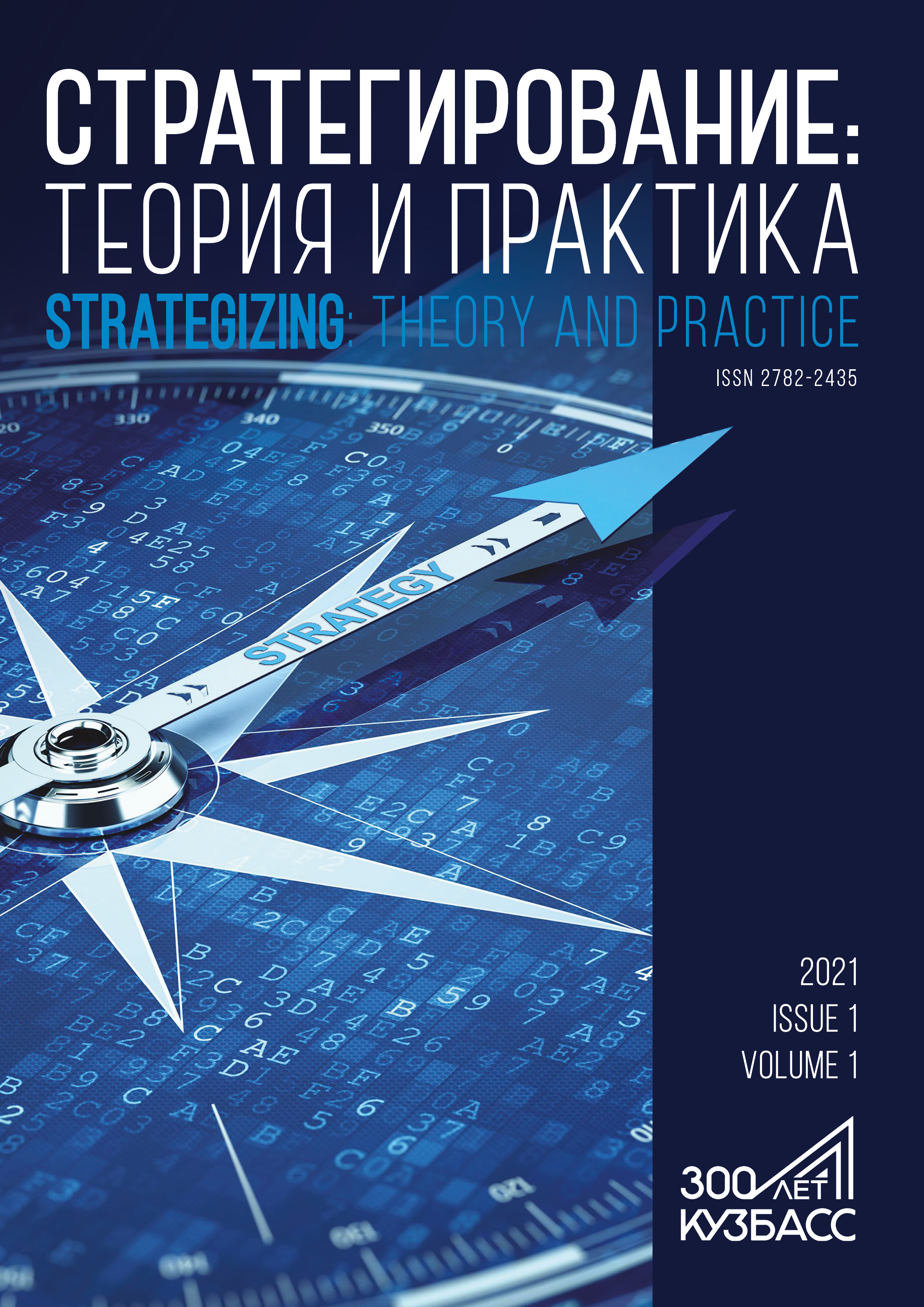Kemerovo, Kemerovo, Russian Federation
Kemerovo, Russian Federation
Abstract: Agglomeration is a traditional form of regional development. However, its place in the modern theory of strategizing has not been sufficiently studied. This research approached the Kemerovo Region as a socioeconomic object of strategizing. It relied on V.L. Kvint’s theory of strategy and methodology of strategizing, e.g., strategy laws, rules of strategic thinking, quantitative analysis of empirical data, etc. The new urban agglomerations need to be asymmetric and unpredictable for competitors, and their strategizing needs new approaches. The Kemerovo Region has two agglomerations, i.e., North Kuzbass and South Kuzbass, which are strategized as inherent parts of the region. In this case, the time-saving rule makes it possible to get ahead of those competitors who prefer more traditional approaches. The strategic priority of the regional agglomeration process possesses a number of competitive advantages, e.g., population density, road network, high urbanization, etc. The strategic project will eventually cover some territories that lack socio-economic ties. Another relevant rule of strategic thinking presupposes a certain commitment to the future, which makes it impossible to rely on the so-called everyday common sense. The Kemerovo Region chose a non-traditional agglomeration path, which ensures its compliance with the laws of strategy and the rules of strategic thinking
strategy theory, strategy methodology, strategic priority, competitive advantage, agglomeration, Kemerovo region – Kuzbass, population, urbanization
1. Boltunov SA, Lapygin YuN. Development of regions and municipalities in search of methods for developing a regional development strategy. Municipal Academy. 2021;(2):115-121. (In Russ.) https://doi.org/10.52176/2304831X_2021_02_115
2. Voroshilov NV. Development of urban agglomerations in the European North of Russia. Federalism. 2021;26(4):54-74. (In Russ.) https://doi.org/10.21686/2073-1051-2021-4-54-74
3. Shabashev VA, Zobova LL, Babun RV, Demchuk NV, Verzhitsky DG, Barylnikov VV, et al. Agglomeration cities: condition, problems, ways of development (the Kemerovo region). Kemerovo: Kuzbassvuzizdat; 2016. 179 p. (In Russ.)
4. Zemlyanukhina NS, Zemlyanukhina SG, Suvorova VV. Quality of life of the Russian population in the context of implementation of the urban agglomerations development strategy. Actual Problems of Economics and Management. 2022;(3):16-26. (In Russ.)
5. Zubarevich NV. Spatial development strategy: priorities and instruments. Voprosy Ekonomiki. 2019;(1):135-145. (In Russ.) https://doi.org/10.32609/0042-8736-2019-1-135-145
6. Kvint VL. The concept of strategizing. 2nd Ed. Kemerovo: Kemerovo State University; 2022. 170 p. (In Russ.) https://doi.org/10.21603/978-5-8353-2562-7
7. Kvint VL. Development of strategy: Scanning and forecasting of external and internal environments. Administrative Consulting. 2015;(7):6-11. (In Russ.)
8. Kvint VL. Theoretical basis and methodology of strategizing of the private and public sectors of the Kuzbass region as a medial subsystem of the national economy. Russian Journal of Industrial Economics. 2020;13(3):290-299. (In Russ.) https://doi.org/10.17073/2072-1633-2020-3-290-299
9. Kvint VL, Novikova IV, Alimuradov MK. Alignment of global and national interest with regional strategic priorities. Economics and Management. 2021;27(11):900-909. (In Russ.) https://doi.org/10.35854/1998-1627-2021-11-900-909
10. Kvint VL, Okrepilov VV. Quality of life and values in national development strategies. Herald of the Russian Academy of Sciences. 2014;84(5):412-425. (In Russ.) https://doi.org/10.7868/S0869587314050107
11. A conceptual future for the Kuzbass region: Strategic outlines of developmental priorities through 2071, a 50-year perspective. Editor Kvint VL. Kemerovo: Kemerovo State University; 2022. 283 p. (In Russ.) https://doi.org/10.21603/978-5-8353-2812-3
12. Mintsberg G, Alʹstrand B, Lampelʹ Zh. Strategicheskoe safari. Ehkskursiya po debryam strategicheskogo menedzhmenta [Strategic safari: A tour through the wilderness of strategic management]. Moscow: Alʹpina Pablisher; 2019. 512 p. (In Russ.)
13. Robets DS. Creation of agglomeration as a way to increase the efficiency of social and economic development of territories (on the materials of the Barnaul agglomeration). Economics of Sustainable Development. 2018;(2):249-255. (In Russ.)
14. Rusanovskiy VA, Brovkova AV, Markov VA. Modeling the effects of spatial localization in urban agglomerations of Russia. Economic Policy. 2018;13(6):136-163. (In Russ.) https://doi.org/10.18288/1994-5124-2018-6-136-163
15. Silin YaP, Animitsa YeG, Novikova NV. Trends in the development of the Ural macroregion's economic space. The Manager. 2017;(2):2-11. (In Russ.)
16. Kharitonov AV, Bondarev NS, Bondareva GS. Formation process of rural aglomeration: Economic mechanism. Moscow Economic Journal. 2021;(5). (In Russ.)
17. Yusupova IV, Golitsyna LA. The development of agglomerations is a key direction of the social and economic development strategy of the Republic of Tatarstan. Regional Economy. South of Russia. 2021;9(2):50-57. (In Russ.) https://doi.org/10.15688/re.volsu.2021.2.6
18. Barca F, McCann P, Rodríguez-Pose A. The case for regional development intervention: place-based versus place-neutral approaches. Journal of Regional Science. 2012;52(1):134-152. https://doi.org/10.1111/j.1467-9787.2011.00756.x
19. Giuliano G, Kang S, Yuan Q. Agglomeration economies and evolving urban form. The Annals of Regional Science. 2019;63:377-398. https://doi.org/10.1007/s00168-019-00957-4
20. Huang X, Li G, Liu J. The impact of spatial structure on economic efficiency of Beijing-Tianjin-Hebei megalopolis in China. Complexity. 2020;2020. https://doi.org/10.1155/2020/6038270
21. Kuddus MdA, Tynan E, McBryde E. Urbanization: A problem for the rich and the poor? Public Health Reviews. 2020;41. https://doi.org/10.1186/s40985-019-0116-0
22. Kvint V. The Global Emerging Market: Strategic Management and Economics. New York: Routledge; 2009. 488 p. https://doi.org/10.4324/9780203882917
23. Liao S, Liu Z, Chaoliang C. Direct and configurational paths of open innovation and organisational agility to business model innovation in SMEs. Technology Analysis and Strategic Management. 2019;31(10):1213-1228. https://doi.org/10.1080/09537325.2019.1601693
24. Pilyasov AN, Goncharov RV. Location of productive forces in Russia in an innovation economy. Regional Research of Russia. 2023;13(1):129-141. https://doi.org/10.1134/S207997052270054X
25. Proost S, Thisse J-F. What can be learned from spatial economics? Journal of Economic Literature. 2019;57(3):575-643. https://doi.org/10.1257/jel.20181414
26. Rigby DL, Brown WM. Who benefits from agglomeration? Regional Studies. 2015;49(1):28-43. https://doi.org/10.1080/00343404.2012.753141
27. Rosenthal SS, Strange WC. How close is close? The spatial reach of agglomeration economies. Journal of Economic Perspectives. 2020;34(3):27-49. https://doi.org/10.1257/jep.34.3.27
28. Suvorova AV. Territorial capital of Russian regions and its spatial organization. R-Economy. 2022;8(2):106-119. https://doi.org/10.15826/recon.2022.8.2.009
29. Zhang W, Liu G, Yang Z. Urban agglomeration ecological risk transfer model based on Bayesian and ecological network. Resources, Conservation and Recycling. 2020;161. https://doi.org/10.1016/j.resconrec.2020.105006







